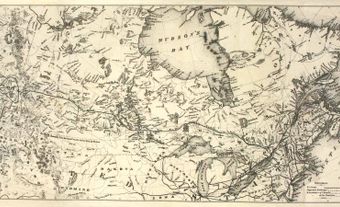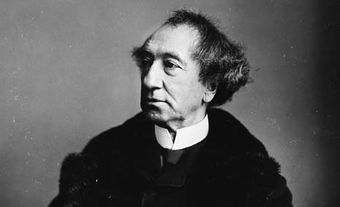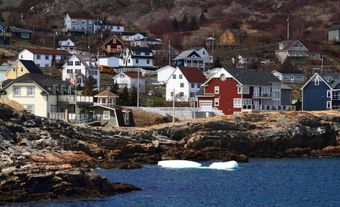Confederation
The Dominion of Canada wasn't born out of revolution, or a sweeping outburst of nationalism. Rather, it was created in a series of conferences and orderly negotiations, culminating in the terms of Confederation on 1 July 1867.

-
October 10, 1849
Opposition to Confederation
Annexation Manifesto
Acute economic depression in Canada led to a short-lived agitation for annexation to the United States.
-
August 03, 1860
Opposition to Confederation
Nova Scotians Elect Joseph Howe
As Premier, Joseph Howe argued that the same electorate should decide if Nova Scotia will join Confederation. He compared the proposed plan for Confederation to uniting Scotland with Poland, making the case that Nova Scotia’s interests did not match Canada’s. Even after 1867, Howe battled to repeal Confederation. When that hope slipped away, he fought to improve the conditions of the agreement for Nova Scotia.
-
June 22, 1864
Confederation
Great Coalition Formed
The Great Coalition was formed. Reform leader George Brown joined a coalition with John A. Macdonald's Conservatives and George-Étienne Cartier's Bleus, starting the process of Confederation in the Province of Canada. The ministers of the Great Coalition were sworn in on June 30.
-
September 01, 1864
Confederation
Charlottetown Conference
John A. Macdonald attended the Charlottetown Conference to persuade the Maritime provinces to join Canadian Confederation.
-
October 10, 1864
Confederation
Québec Conference
Confederation was debated at the Québec Conference, where the Québec Resolutions were agreed upon, paving the way for Confederation. John A. Macdonald is said to have written 50 of the 72 resolutions.
-
October 19, 1864
Confederation
St. Albans Raid
A party of Confederate agents based in Canada raided the town of St. Albans, Vermont. This northernmost land action of the American Civil War caused much tension between Great Britain and the United States. Incidents like the St. Albans Raid increased fears of American expansion north in the lead-up to Canadian Confederation.
-
February 20, 1865

Confederation
Vote for Confederation
The legislative council of the Province of Canada adopted an address urging the Imperial Parliament to pass legislation to achieve the union of British North America. The Assembly adopted the address on March 11.
-
March 04, 1865
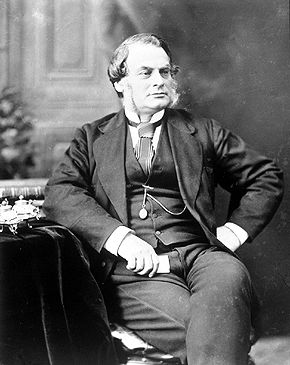
Confederation
Tilley Defeated in NB
The New Brunswick government, led by pro-Confederation Leonard Tilley, was defeated in the only election held on the issue of Confederation.
-
December 04, 1866
Confederation
London Conference
Sixteen delegates from the Province of Canada, Nova Scotia and New Brunswick met with the British government in London, England. During the three month conference, delegates reviewed the Québec Resolutions — creating a document that would form the basis of the British North America Act — chose "Canada" as the name of the new country and designated it a Dominion.
-
March 08, 1867
Confederation
British North America Act
The British North America Act was passed by the British Parliament and given royal assent by Queen Victoria on 29 March. It came into effect on 1 July. The Act joined the colonies of Canada, Nova Scotia and New Brunswick in one federal union. In 1949, Newfoundland becomes Canada’s newest province. In 1999, Nunavut becomes Canada’s newest territory. Its creation establishes self-governance for the region’s Inuit population.
-
March 18, 1867
Confederation
BC Resolution on Confederation Passed
Amor De Cosmos' resolution calling for "the admission of BC into Confederation on fair and equitable terms" was given unanimous support by the colony's legislative council.
-
May 22, 1867
Confederation
Proclamation of Confederation
A royal proclamation declared that the Dominion of Canada would come into existence on July 1.
-
August 07, 1867
Confederation
Conservatives Win First Majority
In the first general election after Confederation, the Conservatives won a majority with 101 seats to the Liberals' 80; Sir John A. Macdonald, who had been chosen prime minister by the Governor General when Canada was created, remained prime minister.
-
September 20, 1867

Confederation
First Election Post-Confederation
Sir John A. Macdonald leads the Conservative Party to victory. Men over the age of 21 who meet property qualifications can vote.
-
July 31, 1868
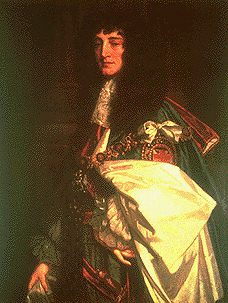
Confederation
Rupert's Land Act
The Rupert's Land Act was passed, allowing the Crown to declare Rupert's Land part of the Dominion of Canada.
-
December 01, 1869
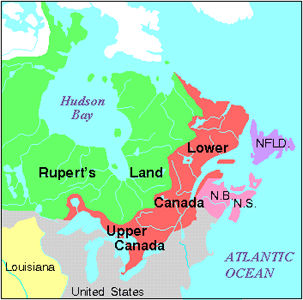
Confederation
HBC Surrenders Rupert's Land
The Hudson's Bay Company surrendered Rupert's Land to the Canadian government.
-
July 15, 1870

Confederation
Manitoba Joins Confederation
The Manitoba Act went into effect, making Manitoba Canada's fifth province.
-
July 15, 1870

Confederation
Transfer of Rupert's Land
The British Crown officially transferred Rupert's Land and the North-Western Territory to Canada. These lands comprise present-day Manitoba, most of Saskatchewan, southern Alberta, southern Nunavut, and northern parts of Ontario and Québec.
-
July 20, 1871

Confederation
British Columbia Joins Confederation
British Columbia entered Confederation as the sixth province. The legislature met for the first time after Confederation on 15 February 1872.
-
August 03, 1871
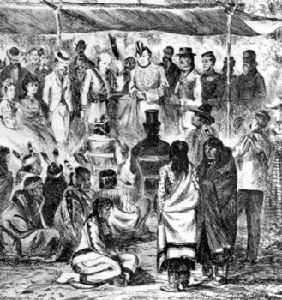
Confederation
Treaty 1
The first post-Confederation treaty was signed at Lower Fort Garry, Man. The first of many “Numbered Treaties,” Treaty 1 was signed between the Crown and the Ojibwe and Swampy Cree Nations. The treaty included the provision of livestock, agricultural equipment and the establishment of schools in exchange for ceding large tracts of Indigenous hunting grounds.
-
August 21, 1871
Confederation
Treaty 2
Treaty 2 was concluded with Chippewa of Manitoba, who ceded land from the mouth of Winnipeg River to the northern shores of Lake Manitoba across the Assiniboine River to the United States frontier.
-
July 01, 1873

Confederation
Prince Edward Island Joins Confederation
Prince Edward Island entered Confederation as Canada's seventh province.
-
October 03, 1873
Confederation
Treaty 3
Treaty 3 was signed by the Saulteaux (Chippewa) of northwestern Ontario and of Manitoba. For the surrender of a tract comprising about 55,000 sq. miles, the Dominion Government reserved not more than one square mile for each family of five and agreed to pay $12 per head and an annuity of $5 per head.
-
September 15, 1874
Confederation
Treaty 4
Treaty 4 was signed at Fort Qu'Appelle, Saskatchewan, with Cree, Saulteaux (Chippewa) and other First Nations.
-
September 20, 1875
Confederation
Treaty 5
Treaty 5 was concluded at Lake Winnipeg ceding an area of approximately 100,000 sq. miles inhabited by Chippewa and Swampy Cree (Maskegon) of Manitoba and Ontario.
-
August 23, 1876
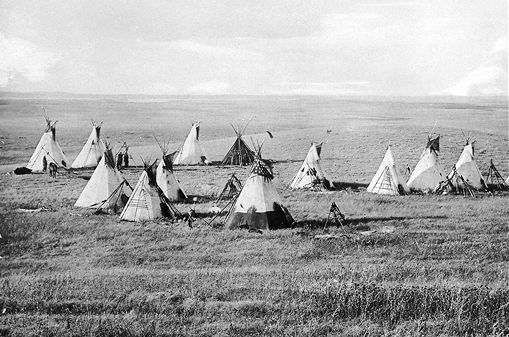
Confederation
Treaty 6
Treaty 6 was signed at Carlton and at Fort Pitt with the Plains Cree, Woodland Cree and Assiniboine. It ceded an area of 120,000 sq. miles of the plains of Saskatchewan and Alberta.
-
September 22, 1877

Confederation
Treaty 7
Treaty 7 was signed at Blackfoot Crossing in southern Alberta by the Siksika, Kainai, Piikani, Tsuut'ina and Stoney. Canadian officials understood that by the treaty First Nations surrendered some 35,000 sq miles of land to the Crown in return for reserves, payments and annuities.
-
June 13, 1898

Confederation
Yukon Becomes Separate Territory
By Act of Parliament the Yukon became a separate territory with a commissioner and partly elected council.
-
June 21, 1899

Confederation
Treaty 8
Cree, Beaver, Chipewyan and Slavey First Nations ceded territory south and west of Great Slave Lake in northern Alberta to the federal government in Treaty 8.
-
September 01, 1905
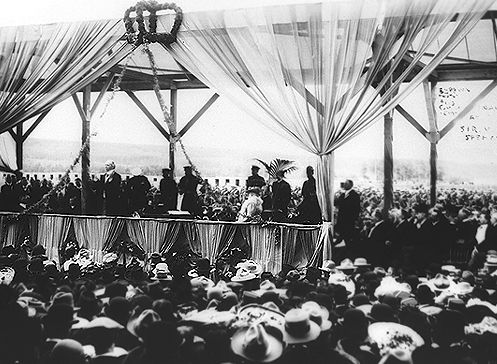
Confederation
Alberta and Saskatchewan Become Provinces
Alberta and Saskatchewan entered Canada as the 8th and 9th provinces by two federal Acts which received royal assent on 20 July. Alberta's boundary with Saskatchewan was set at 110°, though Albertans wanted 107°. The Acts (Autonomy Bills) declared that the West was to have non-denominational schools.
-
December 02, 1933
Confederation
Newfoundland Reverts to Crown
Newfoundland lost its Dominion status due to its financial situation; its constitution was suspended and it reverted to a Crown colony.
-
February 16, 1934

Confederation
Newfoundland Commission Government
Newfoundland began its government by a Commission appointed by Britain.
-
June 03, 1948
Confederation
Newfoundland Votes vs Canada
A Newfoundland referendum resulted in 69,000 votes for self-government, 64,000 for union with Canada, and 22,000 for no change in the island's status. Another vote on 22 July showed a majority of 7,000 for union with Canada.
-
March 31, 1949
Confederation
Newfoundland Becomes Province
Newfoundland entered the Dominion of Canada as the 10th province through an Act of Westminster. The first session of the legislature was held at St. John's on 13 July.
-
February 14, 1973

Confederation
Yukon Land Claims
The federal government established a committee to negotiate land claims in the Yukon.
-
September 07, 1973
Confederation
NWT Court Allows Land Claim
The Northwest Territories Supreme Court allowed the Indian Brotherhood of the NWT to file a land claim for one-third of the NWT.
-
November 12, 1992
Confederation
Inuit Endorse Nunavut
The Inuit endorsed the creation of Nunavut, a semi-autonomous territory, in a referendum.
-
February 15, 1996
Confederation
Nisga'a Land Claim Agreement
Federal and provincial officials signed an agreement of land claims with the Nishga'a in northwestern British Columbia. The Final Agreement calls for cash payments to the Nisga'a of approximately $190 million over a period of years, and recognizes the communal ownership and self-governance of about 2,000 km2 of Nisga’a lands in the Nass River Valley.
-
September 06, 1996
Confederation
Residents Keep NWT Name
Residents of the Northwest Territories voted to keep that name for the western part of territory after the eastern part became the territory of Nunavut in 1999.
-
April 01, 1999

Confederation
Nunavut Declared
The new territory of Nunavut, covering some 2 million sqare kilometers of the eastern Arctic, was declared as part of Canada's first territorial changes since Newfoundland joined Confederation in 1949.
-
December 13, 1999
Confederation
Nisga'a Treaty Approved
The House of Commons voted 217-48 in favour of a bill that would give the Nisga'a of northwest BC the right to self-government. The band received 2000 sq km of land and $253 million. In return they agreed to pay taxes and relinquish future claims.
-
April 13, 2000
Confederation
Nisga'a Treaty
The Nisga'a Treaty was given royal assent by Governor General Adrienne Clarkson.
-
May 11, 2000
Confederation
Nisga'a Final Agreement
The Nisga'a Final Agreement, recognizing Nisga'a lands and self-government, went into effect.
-
June 26, 2014

Confederation
Tsilhqot'in First Nation Granted Title Claim in Supreme Court Ruling
Tsilhqot’in First Nation was granted title to 1,700 km2 of land in British Columbia after a Supreme Court of Canada ruling, the first to grant a declaration of Aboriginal title to a First Nation.

